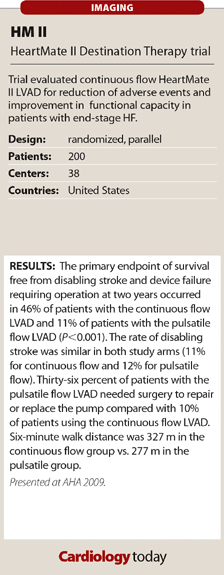HMII: Continuous flow LVAD outperforms pulsatile flow
American Heart Association Scientific Sessions 2009
In the HeartMate II Destination Therapy trial, the continuous flow HeartMate II left ventricular assist device did a better job at improving six-minute walk distance, survival and adverse events compared with the pulsatile flow HeartMate XVE left ventricular assist device.
In the HMII trial, researchers enrolled 200 patients with end-stage HF (NYHA Class III-IV) and implanted them with either the pulsatile flow HeartMate XVE LVAD (n=66) or the continuous flow HeartMate II LVAD (Thoratec Inc., n=134) at 38 U.S. centers between March 2005 and May 2007.
All patients included in the trial were ineligible for a transplant and failed on optimal medical therapy. The HeartMate II LVAD has not been FDA approved for use in patients who are not candidates for cardiac transplantation, Joseph G. Rogers, MD, medical director, cardiac transplant and mechanical circulatory support program at Duke University Medical Center, said during his presentation this morning.
The primary endpoint of survival free from disabling stroke and device failure requiring operation at two years occurred in 46% of patients with the continuous flow LVAD and 11% of patients with the pulsatile flow LVAD (P<0.001). The rate of disabling stroke was similar in both study arms (11% for continuous flow and 12% for pulsatile flow). Thirty-six percent of patients with the pulsatile flow LVAD needed surgery to repair or replace the pump compared with 10% of patients using the continuous flow LVAD.
“By two years, only two patients remained on a pulsatile device, both of whom experienced device replacement,” Rogers said.
Six-minute walk distance was 327 m in the continuous flow group vs. 277 m in the pulsatile group. The secondary endpoint of adverse events was less common in the continuous flow LVAD group compared with the pulsatile flow group.
“We believe that our results support the use of continuous flow LVAD therapy for long-term support in patients with advanced HF,” Rogers said. – by Judith Rusk
For more information:
- Rogers JG. LBCT IV #154. Presented at: American Heart Association Scientific Sessions 2009; Nov. 14-18, 2009; Orlando, Fla.

![]()
This clinical trial clearly demonstrated that the new technology of the miniaturized rotary pumps is superior to the older and larger-sized pumps with excellent quality of life. However, I believe that with reduction of the adverse event rates, and improvement of management, we’ll read better results in the very near future.
– Georg Wieselthaler, MD
University of Vienna, Austria

